Affiliate marketing has emerged as one of the most effective ways for bloggers to monetize their content while providing value to their audience. Whether you’re a seasoned blogger or just starting, affiliate marketing offers an opportunity to earn passive income by promoting products or services you believe in. However, success in this space isn’t just about slapping links on your site—it’s about using strategic best practices that resonate with your readers and align with your content goals.
In this guide, we’ll dive into the world of affiliate marketing for bloggers, explore the best practices that lead to long-term success, and share actionable tips to ensure your affiliate marketing efforts drive real results.
Why Affiliate Marketing Works for Bloggers
Before diving into best practices, it’s essential to understand why affiliate marketing is such an effective revenue stream for bloggers. Here are a few reasons:
- Low Barrier to Entry: Bloggers can start affiliate marketing with minimal investment—often just a website and an audience.
- Scalability: As your blog grows, your affiliate marketing earnings can scale as well. The more traffic and engagement you have, the more potential commissions.
- Passive Income: While setting up your affiliate links and creating content takes time, affiliate marketing has the potential to generate passive income once your content is live and your audience engages with it.
- Trust and Value: When done correctly, affiliate marketing adds value to your audience by recommending products or services that genuinely help them. When readers trust your recommendations, they are more likely to convert, benefiting both them and you.
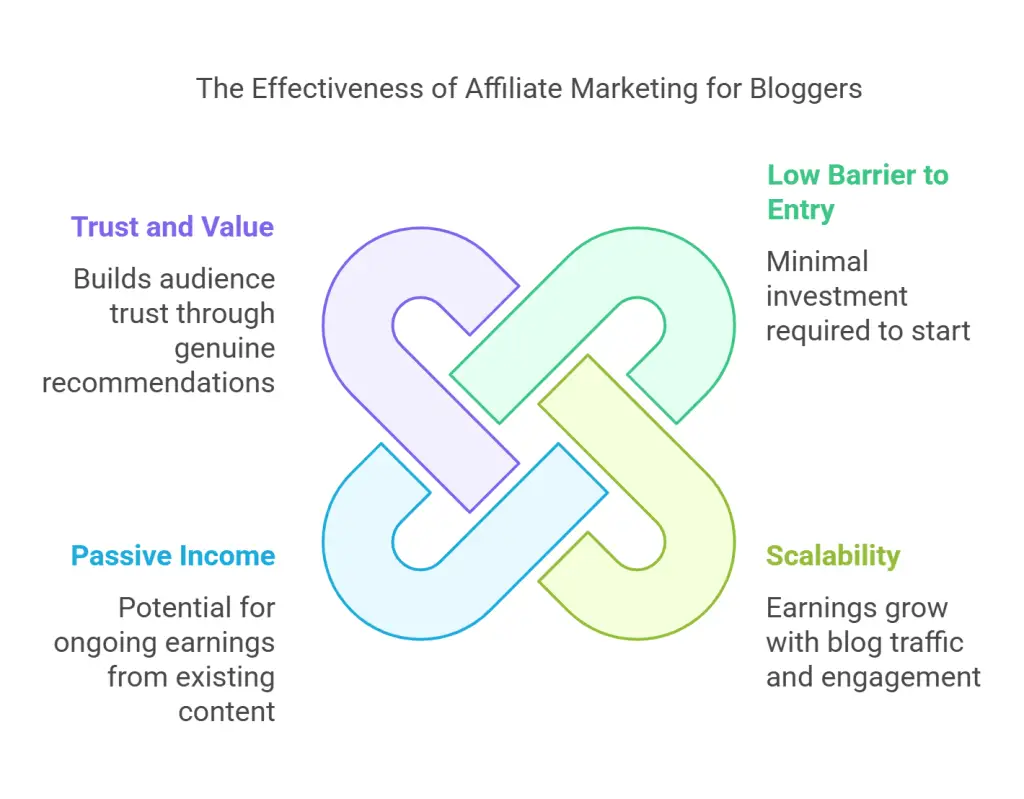
Getting Started with Affiliate Marketing for Bloggers
Starting an affiliate marketing journey as a blogger can be overwhelming, especially with so many products, platforms, and strategies available. Here’s how to kick off your efforts the right way.
Choosing the Right Affiliate Programs
Not all affiliate programs are created equal. Some offer better commissions, while others have more appealing products. Here’s how to choose the best ones:
- Relevance to Your Niche: Ensure the products or services you promote align with your blog’s niche. For example, a fitness blogger would benefit more from promoting workout equipment or supplements than digital marketing courses.
- Commission Structure: Look for programs that offer competitive commissions. Some programs offer a flat rate, while others offer a percentage of the sale.
- Cookie Duration: A longer cookie duration (the time in which a visitor must purchase after clicking your link) increases your chance of earning a commission. Some programs offer a 24-hour cookie, while others last for months.
- Reputation of the Program: Promote products from companies with a good reputation. You don’t want to send your readers to a company with poor customer service or unreliable products.
Some popular affiliate programs include Amazon Associates, ShareASale, Rakuten, and CJ Affiliate, but also look for niche-specific programs directly from product creators or service providers.
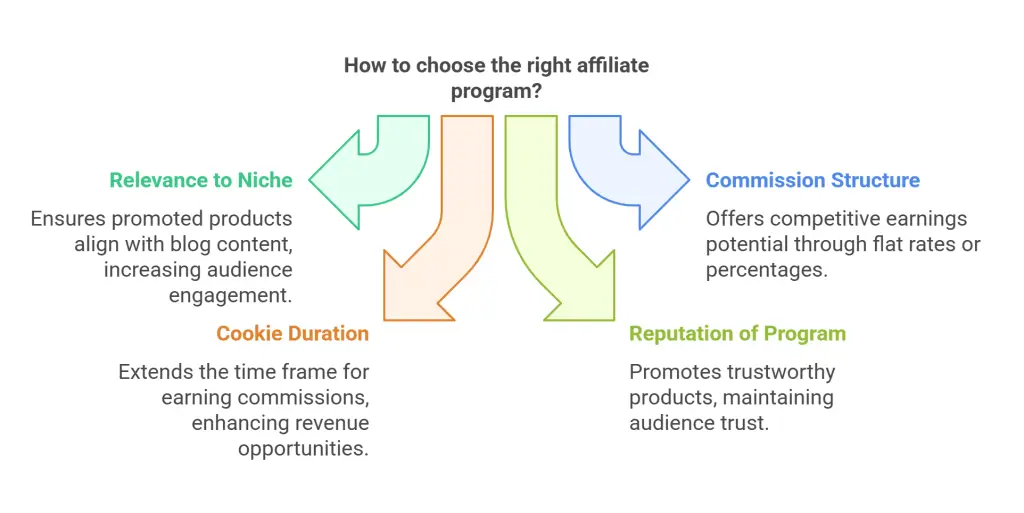
Understanding Your Audience
The foundation of any successful affiliate marketing strategy is understanding your audience. Ask yourself:
- Who are my readers?
- What problems are they looking to solve?
- What kind of products or services would they value?
Take the time to create audience personas to better understand their needs and preferences. When you know your audience, you can tailor your recommendations to resonate more effectively.
Starting with Honest Reviews
One of the best ways to introduce affiliate links into your blog is through honest product reviews. Readers value transparency, and if you’re providing an unbiased, in-depth review of a product you’ve personally used, they’ll be more likely to trust your recommendation.
Make sure your review covers:
- Product Benefits: How will this product make your reader’s life easier or better?
- Drawbacks: No product is perfect, so include some drawbacks to build credibility.
- Real Experiences: Share personal anecdotes and results. These resonate more than generic claims.
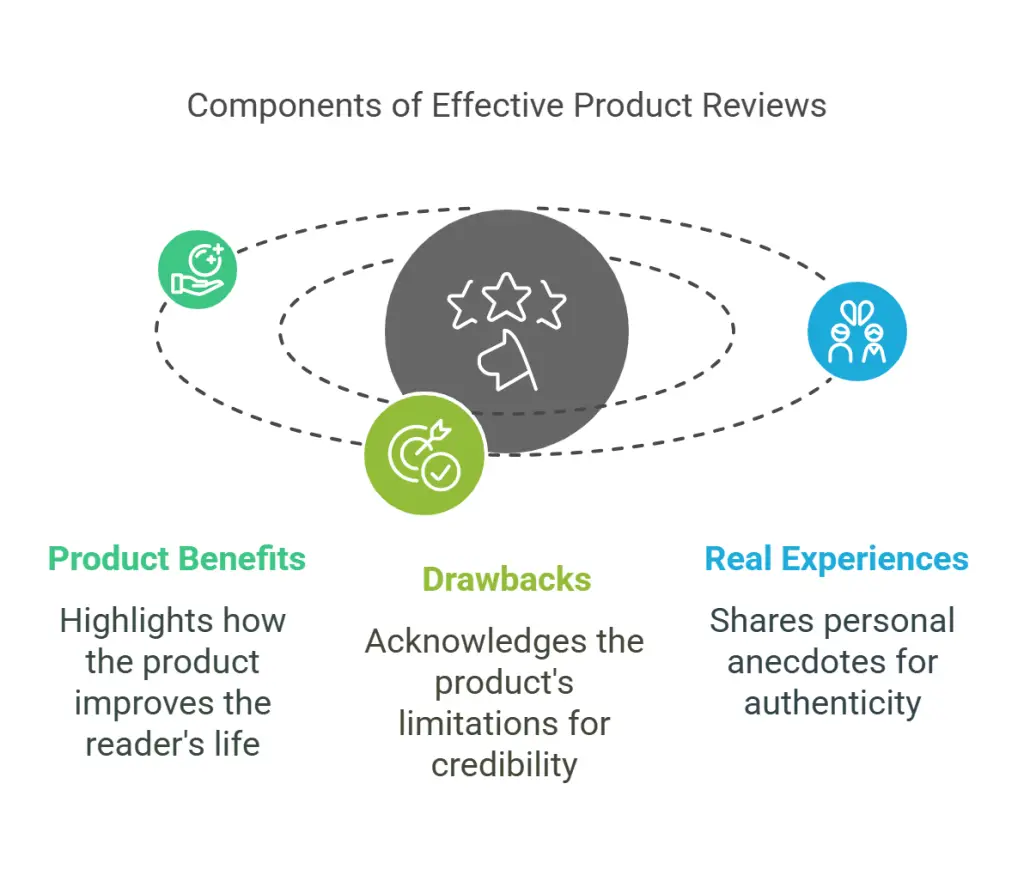
Best Practices for Maximizing Affiliate Marketing Success
Now that you understand the basics of getting started, let’s dive into the best practices that will help you make the most of your affiliate marketing efforts.
Prioritize Quality Content
Content is still king. To succeed with affiliate marketing, you must prioritize creating high-quality, value-driven content. Here are the types of content that work particularly well for affiliate links:
- Product Comparisons: Compare two or more similar products in your niche. These posts are especially useful to readers who are undecided on what to purchase.
- How-To Guides: Create instructional content that naturally weaves affiliate links into the tutorial. For example, a cooking blog could recommend kitchen tools within a recipe post.
- Listicles: Posts like “Top 10 Best Fitness Gadgets” or “5 Must-Have Blogging Tools” allow you to include multiple affiliate links in a single article.
- In-Depth Reviews: As mentioned earlier, in-depth product reviews are a trusted method to include affiliate links. Be genuine in your approach.
Quality content builds trust, which is essential for affiliate conversions. Your readers should feel that your primary goal is to help them, not to make a sale.

Diversify Your Affiliate Partners
While it can be tempting to rely on one or two high-performing programs, diversification is crucial. Relying on a single affiliate partner or product can be risky, especially if the company changes its terms or commissions.
Explore partnerships with different brands and products that still align with your blog’s mission. This also gives you a broader range of products to recommend, helping you appeal to different segments of your audience.
Be Transparent and Authentic
Transparency is key in affiliate marketing. Your readers should always be aware that you stand to earn a commission from the products you’re recommending. This builds trust and ensures compliance with laws and regulations, such as the FTC’s guidelines.
How to be transparent:
- Disclose at the Beginning: Place a disclosure at the start of your post or within the content near affiliate links.
- Use Clear Language: Don’t hide your disclosure in complicated legal jargon. A simple “I may earn a small commission if you make a purchase through these links, at no extra cost to you” is sufficient.
- Keep It Authentic: Only recommend products you’ve used and believe in. Your readers will sense inauthenticity if you’re promoting something you don’t genuinely support.
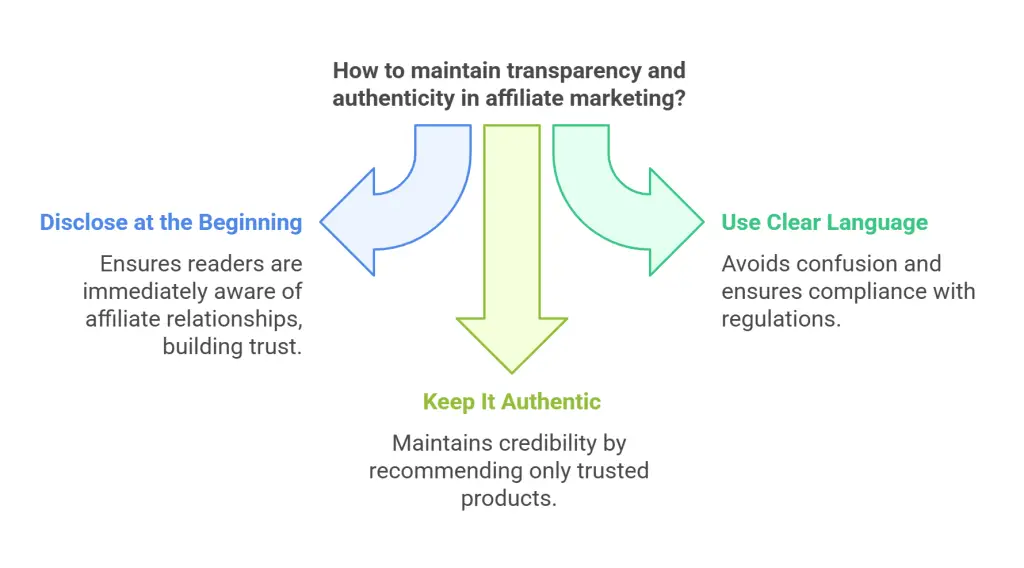
Optimize Your Blog for Conversions
It’s not enough to simply add affiliate links to your blog—you must ensure your site is optimized to convert those clicks into sales. Here are some ways to optimize your blog for conversions:
- Strategic Placement: Place your affiliate links in areas where they will naturally attract attention, such as within the first few paragraphs of a post, after key takeaways, or as call-to-action buttons.
- Create a Resources Page: Many successful bloggers have a “Resources” or “Tools I Use” page where they list recommended products or services with affiliate links.
- Utilize Banners and Widgets: Some affiliate programs provide banners or widgets you can place in your sidebar or within your content. Just ensure they don’t overpower your site or feel spammy.
- Use SEO Best Practices: Optimize your posts for search engines by incorporating relevant keywords. This increases the chances of your content being discovered by people actively searching for the products you promote.
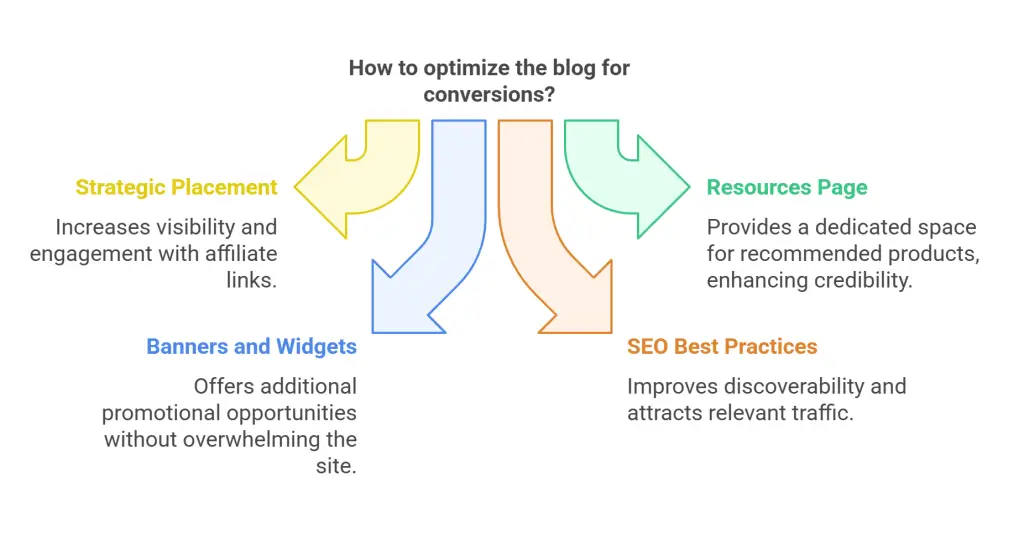
Test and Track Performance
To continually improve your affiliate marketing strategy, it’s important to track the performance of your affiliate links. Most affiliate programs offer dashboards where you can see clicks, conversions, and earnings, but you can also use tools like Google Analytics to dive deeper.
Key metrics to track include:
- Click-Through Rate (CTR): How many people are clicking your affiliate links? A low CTR might mean your links are not positioned well or your content isn’t engaging enough.
- Conversion Rate: Out of the clicks you’re getting, how many are converting into sales? A low conversion rate could mean the product doesn’t resonate with your audience.
- Average Order Value: Some products offer lower commissions but higher conversion rates, while others may have a higher order value that results in bigger commissions.
Testing different strategies and links is key to finding out what works best for your audience.
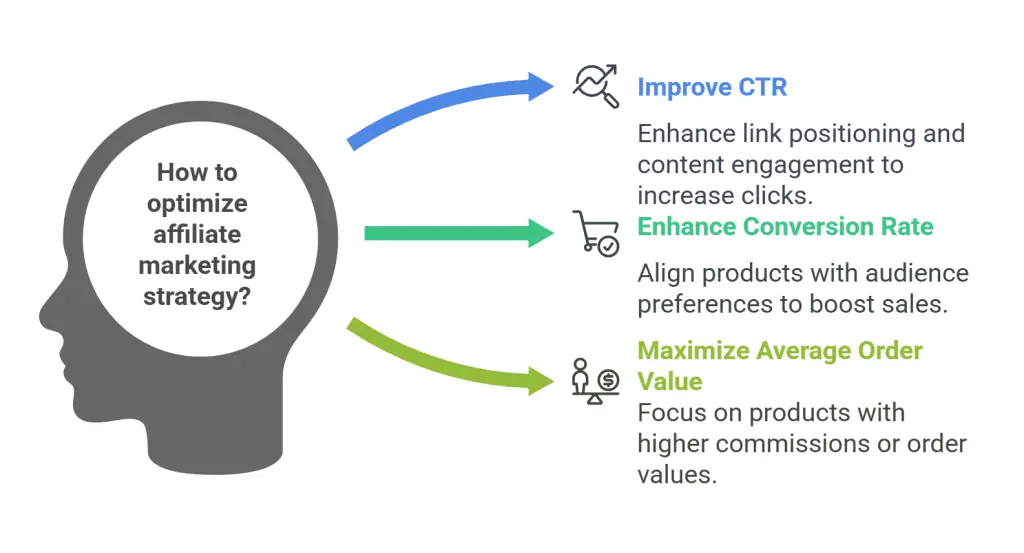
Case Study – An Example of Successful Affiliate Marketing
To illustrate how affiliate marketing works in practice, let’s explore the journey of Bethany, a fitness blogger, who successfully used affiliate marketing to turn her blog into a revenue-generating platform.

Bethany’s Challenge
Bethany runs a small fitness blog, “FitLife Journal,” focused on workout routines, nutrition tips, and wellness. She had a loyal following but struggled to generate substantial income from her blog. After reading about affiliate marketing, Bethany decided to give it a try.
Researching Affiliate Programs
Bethany wanted to promote products that aligned with her audience. She joined several fitness-related affiliate programs, including one for protein supplements, another for workout equipment, and one for fitness apparel. She chose these programs because they aligned with her readers’ interests, and she personally used the products.
Integrating Affiliate Links Naturally
Bethany wrote several blog posts that incorporated affiliate links naturally. One of her most successful articles was “5 Essential Supplements for Muscle Recovery,” where she provided an honest review of each supplement, including both the benefits and drawbacks.
Building a Resources Page
Bethany also created a dedicated “Favorite Fitness Tools” page on her blog. On this page, she listed the exact equipment she used in her home gym and included affiliate links to each item. Since many readers were curious about her routines, this page became a valuable resource for her audience.
Focusing on Quality Content
Bethany didn’t rely solely on product reviews. She continued to produce high-quality content, such as workout guides, meal plans, and motivational blog posts. She made sure her affiliate links fit naturally within her content without overwhelming the reader.
Optimizing for SEO
To drive organic traffic, Bethany optimized her posts with relevant keywords like “best supplements for muscle recovery” and “home workout equipment.” This helped her attract more readers, many of whom were already looking for the products she recommended.
The Results
Within a few months, Bethany’s affiliate marketing efforts began to pay off. Her blog traffic increased, and she saw consistent sales from her affiliate links. By the end of the year, Bethany had diversified her income streams and was earning a steady passive income through her blog.
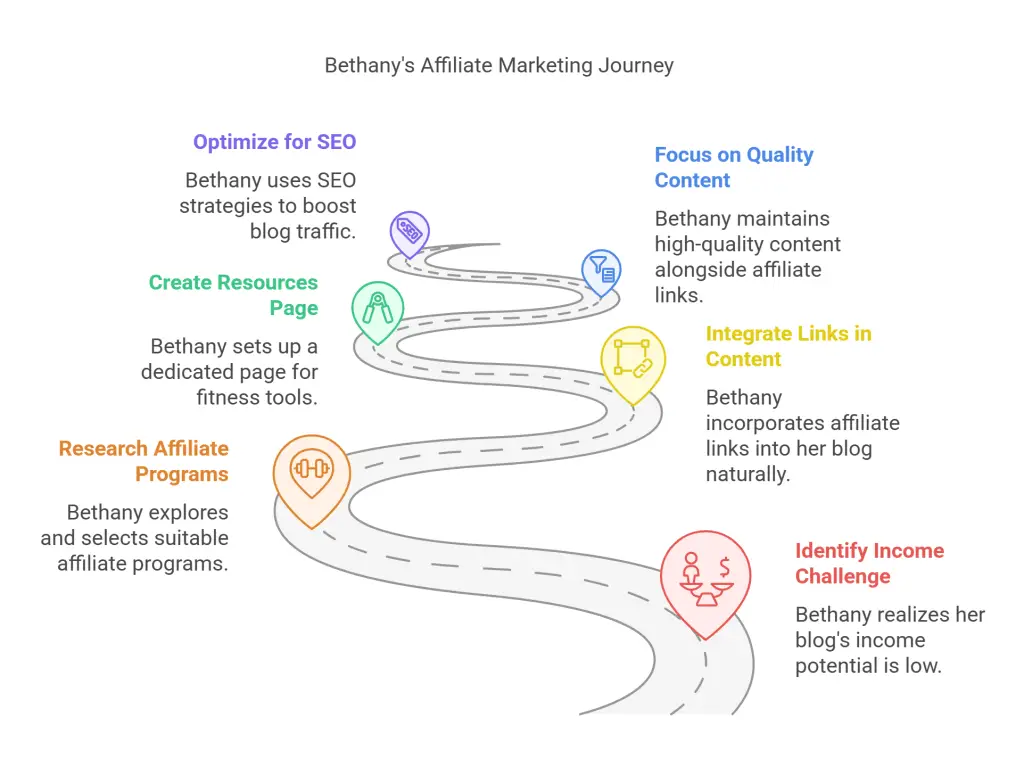
Overcoming Challenges in Affiliate Marketing for Bloggers
While affiliate marketing offers excellent opportunities, it comes with challenges. Here’s how to tackle them.
Low Conversion Rates
One of the biggest hurdles bloggers face is converting readers into buyers. To improve your conversion rates:
- Use Strong Calls to Action (CTAs): Encourage readers to click on your affiliate links with clear, compelling CTAs.
- Offer Bonuses: If possible, offer exclusive bonuses or discounts through your affiliate links. Some programs allow you to provide special offers.
- Test Different Products: Sometimes, a product just doesn’t resonate with your audience. If your conversion rates are low, consider testing different products or services.
Balancing Content and Monetization
It’s easy to get carried away with affiliate links, but overloading your content with too many links can damage the reader experience. Striking the right balance between providing valuable content and monetizing your blog is essential. The solution is to prioritize reader value and weave affiliate links naturally into your content.
Complying with Regulations
Affiliate marketers must comply with advertising regulations, such as the FTC’s guidelines. Not doing so can lead to fines or damaged reputation. Always disclose your affiliate relationships clearly and avoid misleading claims.
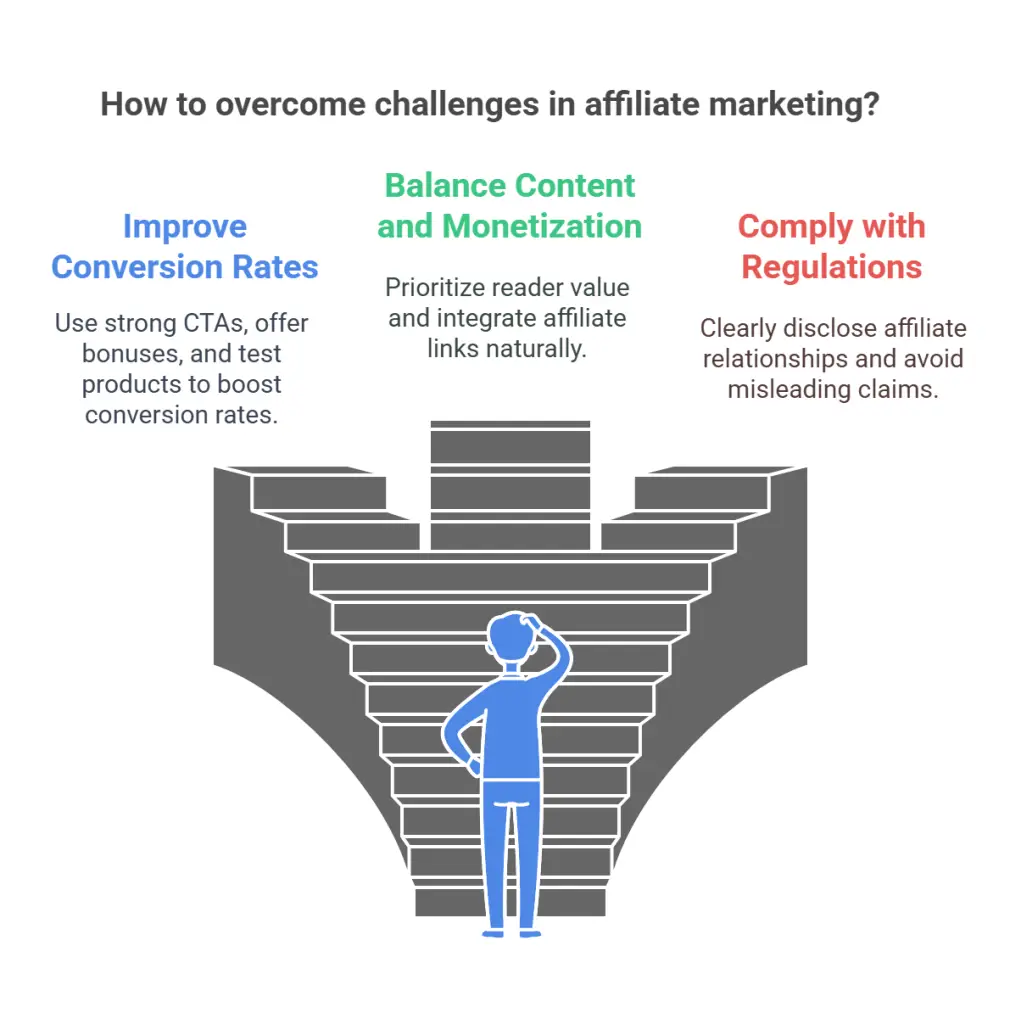
Conclusion
Affiliate marketing for bloggers is a powerful way to build a sustainable income stream while maintaining the integrity of your content. When approached thoughtfully and strategically, it allows bloggers to monetize their platforms without compromising the reader experience. By selecting affiliate programs that align with your blog’s niche and audience, you ensure relevance and authenticity. Creating high-quality, value-driven content that naturally incorporates affiliate links is key to engaging your readers and driving conversions. Transparency about your affiliate relationships also fosters trust, which is essential for long-term success.
To maximize the potential of affiliate marketing for bloggers, it’s important to optimize your blog for conversions and consistently track performance to refine your strategies. Diversifying your affiliate partnerships can help mitigate risks and open up new income opportunities. By staying committed to providing genuine value to your audience, affiliate marketing for bloggers can evolve into a sustainable and profitable aspect of your blogging journey. With dedication and the right approach, you can turn your blog into a thriving revenue stream while keeping your readers’ trust and satisfaction at the forefront.
Frequently Asked Questions
What is affiliate marketing for bloggers?
Affiliate marketing allows bloggers to earn commissions by promoting relevant products or services. By integrating affiliate links into their content, bloggers provide value to readers while generating income. This monetization strategy works best when recommendations align with the blog’s niche.
How can bloggers choose the right affiliate programs?
Bloggers should select affiliate programs that match their niche and audience’s interests. Choosing relevant products ensures authenticity, increases engagement, and boosts conversion rates. Researching commission structures, product quality, and brand reputation is also crucial.
Why is trust important in affiliate marketing?
Building trust with an audience is key to successful affiliate marketing. Bloggers should offer genuine recommendations and transparently disclose affiliate partnerships. Authenticity enhances credibility, encourages reader loyalty, and increases the likelihood of conversions.
How should bloggers integrate affiliate links into content?
Bloggers should incorporate affiliate links naturally within high-quality, informative content. Links should be relevant and add value to the reader’s experience. Avoid overloading posts with links, as this can reduce credibility and negatively impact engagement.
How can bloggers improve their affiliate marketing performance?
Regularly analyzing affiliate performance helps bloggers refine their strategies. By tracking clicks, conversions, and audience preferences, they can focus on promoting high-performing products, optimizing content, and improving marketing techniques for better results.
Further reading
Patrick Stox. “Affiliate Marketing Blogging: How to Make Money & Rank in Google.” Ahrefs Blog, last modified March 2024. https://ahrefs.com/blog/affiliate-marketing-blogging/. Accessed March 11, 2025.
Reddit Users. “I Am Thinking to Start an Affiliate Blogging Website, What Are Your Thoughts?” Reddit /r/Blogging, March 2024. https://www.reddit.com/r/Blogging/comments/1ala1r7/i_am_thinking_to_start_an_affiliate_blogging/?rdt=52345. Accessed March 11, 2025.
Santrel Media. “How to Start Affiliate Marketing for Beginners (Step by Step).” YouTube video, 15:34. Posted February 7, 2023. https://www.youtube.com/watch?v=nP2DDlsA4dU. Accessed March 11, 2025.
Adam Enfroy. “Affiliate Marketing in 2024: Still Worth It?” YouTube video, 12:45. Posted January 12, 2024. https://www.youtube.com/watch?v=C_xQX1TJcNw. Accessed March 11, 2025.
Reddit Users. “Is Affiliate Marketing Still Worth It in 2024?” Reddit /r/Blogging, February 2024. https://www.reddit.com/r/Blogging/comments/1cfzu52/is_affiliate_marketing_still_worth_it_in_2024/. Accessed March 11, 2025.







